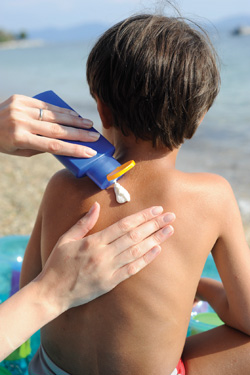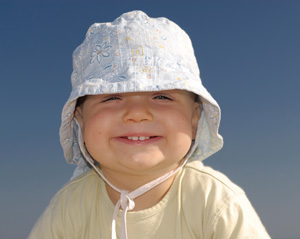 Those long, hot summer days aren’t far away, and for some kids, neither are sunburns. Every year, lots of kids — especially those with fair skin, red hair and blue eyes — sizzle their pelts in the sun. Those burns aren’t just painful, they bring with them increased risk of ugly skin damage and even potentially deadly skin cancer — problems that are easy to avoid, thanks to a multitude of sunburn-beating products on the market.
Those long, hot summer days aren’t far away, and for some kids, neither are sunburns. Every year, lots of kids — especially those with fair skin, red hair and blue eyes — sizzle their pelts in the sun. Those burns aren’t just painful, they bring with them increased risk of ugly skin damage and even potentially deadly skin cancer — problems that are easy to avoid, thanks to a multitude of sunburn-beating products on the market.
Sun safety for kids
For starters, parents should cover little ones in three ways, according to Robert Sidbury, M.D., chief of dermatology at Seattle Children’s. “Take a cue from the Australians, where melanoma is very common, and ‘slip, slap and slop,’” says Sidbury. “Slip on a shirt, slap on a hat and slop on some sunscreen. Sunscreen is just one part of sun safety.”
Add to that a healthy sense of timing and you’ll be doing your best for your child, according to Janie Leonhardt, M.D., a dermatologist at Virginia Mason Medical Center. “The best protection for children against the harmful effects of ultraviolet light is avoidance by limiting midday sun exposure from 10 a.m. to 4 p.m.,” she says. Essentially, stay out of the sun, and if you do go out, seek shade whenever possible.
Leonhardt also recommends wearing sun-protective clothing, which is easy to find at REI and other sporting-goods stores, and from Seattle’s Sun Precautions (sunprecautions.com), which manufactures clothing with sun protection equal to 30 SPF.
 Sunscreen for kids
Sunscreen for kids
Even with sun-blocking clothing, kids’ skin should be coated regularly with a good sunscreen, says Robin Hornung, a dermatologist at the Everett Clinic. With a baffling array of products available, what type of sunscreen should you buy?
Hornung tends to trust the major brands. As for SPF, the American Academy of Dermatology (AAD) recommends an SPF of 30 or higher for children. SPF — or sun protection factor — refers to the sunscreen’s ability to block ultraviolet B (UVB) rays, which cause sunburns, but not ultraviolet A (UVA) rays, which are usually linked to deeper skin damage. The higher the SPF, the more UVB rays are blocked; an SPF 30 product blocks about 97 percent of UVB rays. No sunscreen product offers 100 percent protection.
Though sunscreen sprays are convenient, they often contain alcohol to help them dry faster, which can irritate a child’s skin, Hornung says. And spraying them around a child’s face is not a good idea, because the chemicals can be inhaled or get into the eyes. Instead, Hornung recommends parents spray it into their hands and then apply it to a child’s face.
And don’t skimp on the slop. “The biggest mistakes people make when applying sun protection is not applying enough or often enough,” says Leonhardt, who recommends this rule for the average-size adult: Apply 1 full ounce — about as much as would fill a shot glass — and rub it in completely. For children, Leonhardt recommends a thick application be applied to every exposed area of the skin and reapplied every two to three hours or after coming out of the water.
And check for an expiration date when you buy; sunscreen is only good for about three years, says Hornung. Many of the major brands will have a date printed on the bottle, but if yours does not, write your date of purchase on the bottle. Toss it out if you still have it three years later.
Use baby sunscreen beginning at 6 months of age, says the AAD; it’s best to keep babies younger than 6 months out of the direct sun.
Skin cancer risks
Though the occasional sunburn seems a part of life, skin cancer is serious and on the rise among young people, Leonhardt says. “Melanoma is the second-most-common cancer in women between ages 20 and 29 in the United States. The incidence of melanoma has increased 690 percent from 1950 to 2001.
“I have seen and treated a basal cell carcinoma in a 16-year-old young woman whose only risk factor was poor sun protective habits and chronic exposure to ultraviolet light as a lifeguard,” Leonhardt says, a condition that is more common in adults, because damage due to ultraviolet light is cumulative. She recommends that everyone perform a monthly self-exam of their skin, looking for spots that are changing in size, shape or color, or that stand out from other spots — “ugly ducklings,” she calls them. “New moles do develop through childhood and grow as children grow, but out-of-proportion growth would be a red flag.” Patients who have a family history of melanoma — or who have more than 50 moles — have a higher risk of developing melanoma, Leonhardt says, and should see a dermatologist once a year.
Kathleen F. Miller is a Sammamish freelance writer and mother of two.











